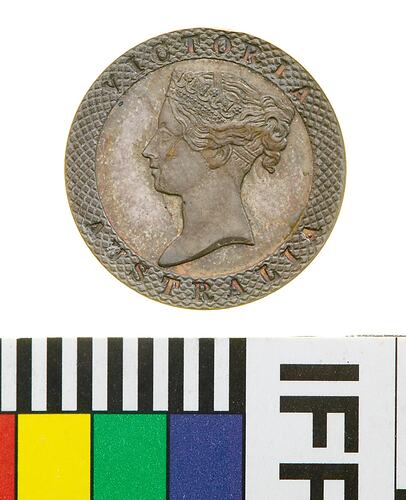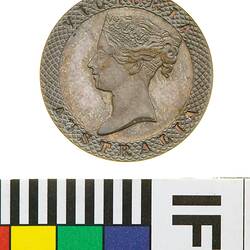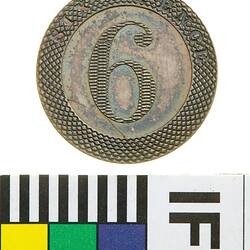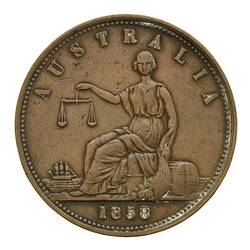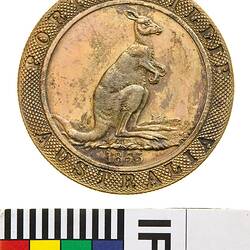Summary
Silver Six Pence Pattern token, minted by W.J. Taylor of London. It was supposedly issued from the Kangaroo Office, in Melbourne, Victoria.
W. J. Taylor and his business partners established the Kangaroo Office to take advantage of the explosive economic growth in Australia following the discovery of gold in 1851. They hoped to buy gold at greatly reduced prices from the gold fields and then release it at full value in the form of quarter-ounce, half-ounce, one ounce and two ounce gold coins. However due to the time required to travel between London and Melbourne, once the Kangaroo Office was ready for business in 1854, an increase in the number of British sovereigns, had seen the price of gold rise, and the potential profits for the Kangaroo Office sharply decline. Not deterred, in late 1954 Taylor prepare dies for a series of pattern copper tokens that it was hoped could be produced in Melbourne by the Kangaroo Office for circulation within Australia. It appears that this did not succeed, and in 1855 Taylor began to create shilling and sixpence patterns in silver. However the Kangaroo Office again failed to obtain authority to strike and circulate these silver tokens and in 1857 the Kangaroo Office closed.
Physical Description
A plain edged silver strike (19 mm diameter) of a proposed shillin token. It features a crowned head of Queen Victoria facing left within a broad machine-turned rim that bears the incuse legend VICTORIA AUSTRALIA. The reverse features a large numeral 6 within a broad machine-turned rim that bears the incuse legend SIX PENCE.
Obverse Description
At centre a crowned head of Queen Victoria facing left within a broad machine-turned rim that bears the incuse legend VICTORIA AUSTRALIA.
Reverse Description
At centre, a large numeral 6 within a broad machine-turned rim that bears the incuse legend SIX PENCE
Edge Description
Plain
More Information
-
Collecting Areas
-
Acquisition Information
Transfer from National Gallery of Victoria (NGV), 15 Mar 1976
-
Date Issued
circa 1865 AD
-
Issued By
Kangaroo Office (Mint), Melbourne, Greater Melbourne, Victoria, Australia
-
Mint
W.J.Taylor, Mint, London, England, Great Britain, circa 1865
-
Inscriptions
Obverse: VICTORIA AUSTRALIA Reverse: 6 SIX PENCE
-
Denomination
-
Series
-
Material
Silver
-
Axis
12
-
Classification
-
Category
-
Discipline
-
Type of item
-
Dimensions
19 mm (Outside Diameter), 2.863 g (Weight)
-
Shape
Round
-
References
[Book] Andrews, Arthur. 1921. Australasian Tokens and Coins., No. 797, pp.127-128 Pages
Related to No. 6
-
Keywords
